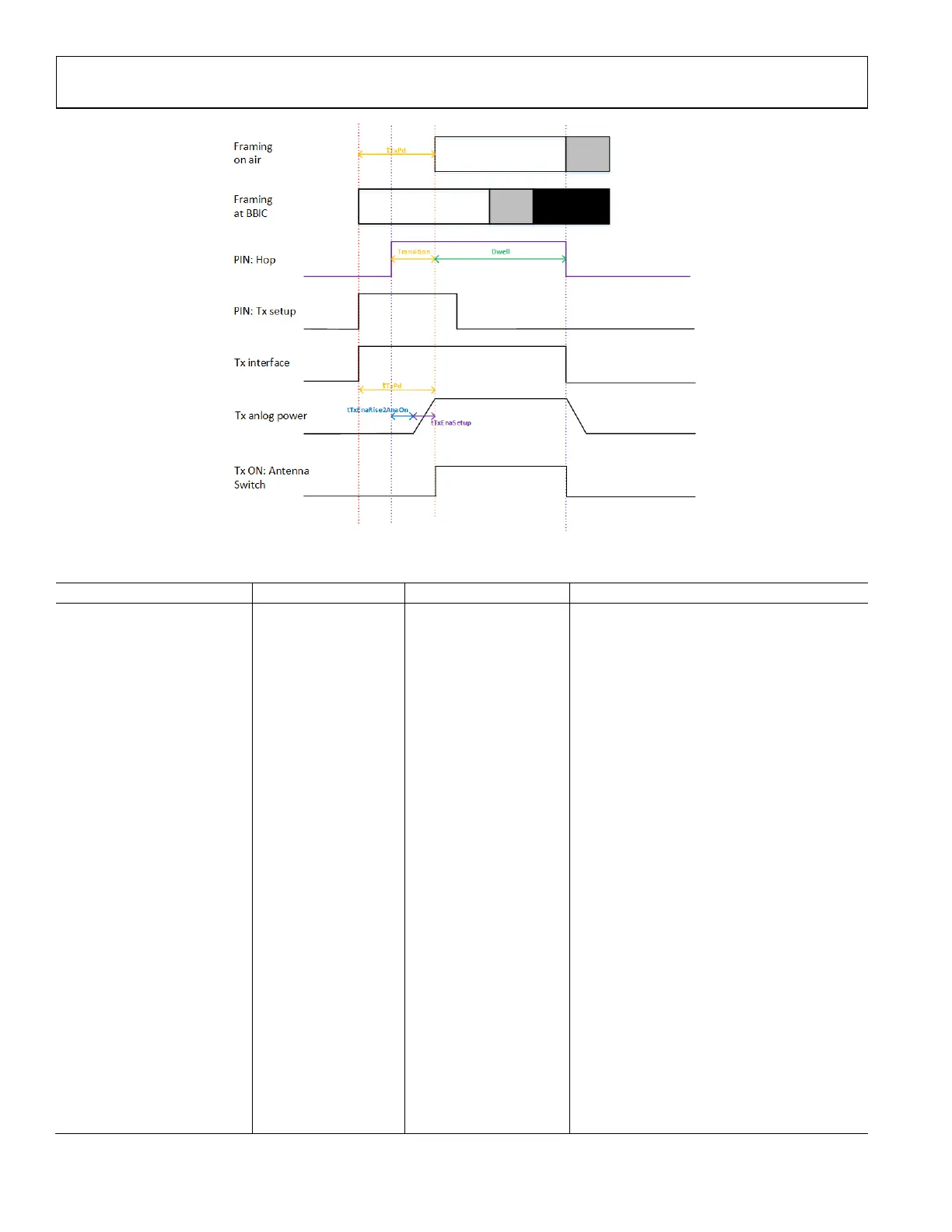UG-1828 Preliminary Technical Data
Rev. PrB | Page 114 of 277
RECEIVER/OBSERVATION RECEIVER SIGNAL CHAIN
The ADRV9001 offers dual receive channels. With a minimum number of external components, each receive channel could build a
complete RF-to-bits signal chain which serves as RF front end for a wide range of applications. It supports both time division duplexing
(TDD) and frequency division duplexing (FDD) modes and reception of both narrowband (NB) and wideband (WB) signals up to 40
MHz. NB applications include DMR, P25 and TETRA, while WB applications are geared towards LTE transmissions. For example,
ADRV9001 supports standard sample rates of 24 kHz (typically for FM waveforms), 144 kHz and 288 kHz (typically for TETRA signals),
and 1.92 MHz, 3.84 MHz, 7.68 MHz, 15.36 MHz, 23.04 MHz, 30.72 MHz, and 61.44 MHz (typically for LTE signals). Besides those
standard rates, the ADRV9001 is also capable of supporting an almost continuous range of sample rates between 24 kHz and 61.44 MHz.
Some sample rates could not be supported due to internal clocking constraints.
Rx2
HP ADC
AFE
RX1A+
RX1A–
RX1B+
RX1B–
Rx1
DFE
DIGITAL SIGNAL PROCESSING:
– NARROW/ WIDE BAND DECIMATION
– DC OFFSET CORRECTION (DC)
– QUADRATURE ERROR CORRECTION (QEC)
– NUMERICALLY CONTROLLED OSCILLATOR (NCO)
– PROGRAMMABLE FIR FILTER (pFIR)
– RECEIVER SIGNAL STRENGTH INDICATOR (RSSI)
– FREQUENCY OFFSET CORRECTION
– PHASE OFFSET CORRECTION
– OVERLOAD DETECTORS
DATA PORT
CMOS-SSI
OR
LVDS-SSI
TO
BBP
LP ADC
LP ADC
HP ADC
INTERNAL
OBSERVATION
LPF
LO1
LO2
LPF
90°
0°
24159-095
Figure 122. Top Level Structure of ADRV9001 Dual Receiver
Figure 122 describes the top-level structure of the ADRV9001 receivers. As shown in Figure 122, each receive path Rx1 or Rx2 contains 2
major subsystems, the Analog Front End (AFE) and the Digital Front End (DFE). The AFE subsystem contains 4 major components,
which are programmable front end attenuator, matched I and Q mixer, low pass filter (LPF) and analog-to-digital converter (ADC). The
attenuators are used to control the signal gain to avoid overloading the datapath when a strong interfering signal presents. It is followed
by the mixers to down convert the received signals for digitization. The output current of the mixers is further converted to voltage and
filtered by LPFs before passing to ADCs. The ADRV9001 provides two pairs of ADCs, a pair of high performance (HP) ADCs to achieve
high linearity performance and a pair of low power (LP) ADCs with slightly less linearity performance but significant lower power
consumption. This design allows for a flexible trade-off between power consumption and linearity performance.
The DFE subsystem contains a series of digital signal processing components such as sample rate decimation (DEC), dc offset correction (DC),
quadrature error correction (QEC), digital down conversion (DDC) with numerically controlled oscillator (NCO), a programmable 128-tap
FIR filter (PFIR), receiver signal strength indicator (RSSI), frequency offset correction (FOC), phase offset correction (POC) and
overload detectors. DEC is used to decimate the ADC sample rate to the desired output sample rate. DC, QEC, PFIR, FOC and POC are
used to condition the digital signals at different stages of the datapath for optimal performance. Overload detectors are used for gain
control in the datapath. RSSI provides signal power measurement to control the bit-width of the output signal. In addition, it could be
used to detect the presence of a signal in a desired frequency band. At the end of the signal chain, through CMOS-SSI or LVDS-SSI data
port, the output signal is delivered to based band processor for further processing.
The ADRV9001 supports a RF local oscillator (LO) range from 30 MHz to 6 GHz. RF LOs can be generated via two internal phase lock
loops (PLL) or applied externally to the part. The digital subsystem contains an optional digital mixer that is driven by a programmable
NCO. Receiver LO can offset from the frequency of the desired channel and then make use of the digital mixer to down convert the
signal to baseband before being processed by baseband processor. There are several advantages to offset the receiver LO from the
frequency of the desired channel: Impairments that exist around the receiver LO, such as LO-leakage, can be avoided. The effect of flicker
noise from baseband circuits can be mitigated since the received signal is offset from dc in the analog signal path. Also, image rejection
can be improved if the receiver LO is offset enough from the desired channel, such that the image frequency lies in the attenuation region
of the user’s external RF filter. IF operation could work with both NB and WB applications. Typically, when the receiver is operating in
NB mode, the sensitivity requirements for these applications demand very low noise performance, therefore, the intermediate frequency
(IF) approach is preferred. The device is capable of receiving signals offset from the carrier, as well as an IF down conversion scheme.
When the receiver is operating on a WB signal, it could use direct down conversion or zero IF (ZIF) (although IF approach is also
available for WB signal). In this mode the DDC will be bypassed.

